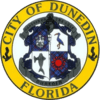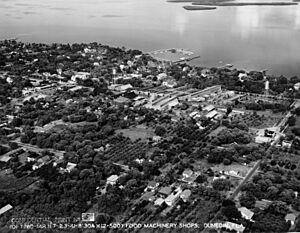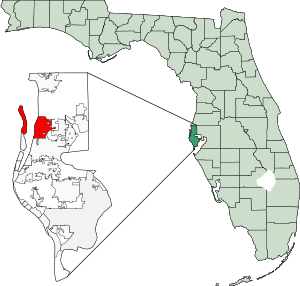Dunedin, Florida facts for kids
Quick facts for kids
Dunedin, Florida
|
||
|---|---|---|
| City of Dunedin | ||
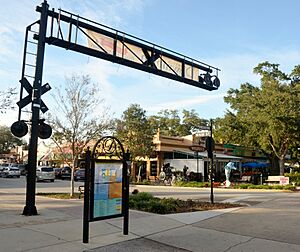
Downtown Dunedin
|
||
|
||
| Motto(s):
"Dunedin on the Gulf"
|
||
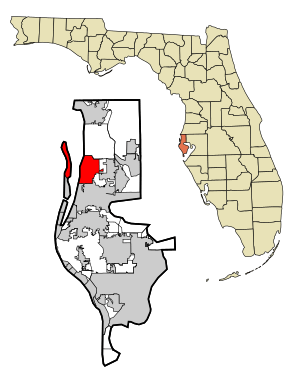
Location in Pinellas County and the state of Florida
|
||
| Country | United States | |
| State | Florida | |
| County | Pinellas | |
| Settled (Jonesboro) | 1850 | |
| Incorporated (Town of Dunedin) |
1899 | |
| Incorporated (City of Dunedin) |
1926 | |
| Government | ||
| • Type | Commission–Manager | |
| Area | ||
| • Total | 22.94 sq mi (59.42 km2) | |
| • Land | 10.41 sq mi (26.96 km2) | |
| • Water | 12.53 sq mi (32.46 km2) | |
| Elevation | 30 ft (9 m) | |
| Population
(2020)
|
||
| • Total | 36,068 | |
| • Estimate
(2023)
|
35,930 | |
| • Density | 3,465.08/sq mi (1,337.87/km2) | |
| Time zone | UTC-5 (Eastern (EST)) | |
| • Summer (DST) | UTC-4 (EDT) | |
| ZIP codes |
34697-34698
|
|
| Area code(s) | 727 | |
| FIPS code | 12-18575 | |
| GNIS feature ID | 0281860 | |
Dunedin (/dəˈniːdɪn/) is a city in Pinellas County, Florida, United States. Its name comes from Dùn Èideann, which is the Scottish Gaelic name for Edinburgh, the capital of Scotland. Dunedin is part of the larger Tampa–St. Petersburg–Clearwater metropolitan area. It is the fifth largest city in Pinellas County. In 2020, about 36,068 people lived there.
Dunedin has several beautiful beaches. These include Dunedin Causeway, Honeymoon Island, and Caladesi Island State Park. Caladesi Island is often called one of the best beaches in the world. Dunedin is special because it's one of the few places along the coast where buildings don't block the amazing views of the Intracoastal Waterway and the Gulf of Mexico. A mile-long stretch of Edgewater Drive offers clear views of St. Joseph Sound, Clearwater Beach, and Caladesi Island. Downtown Clearwater and Clearwater Beach are just a short drive south.
Contents
- Dunedin's Past: A Look at Its History
- Where is Dunedin? Understanding its Geography
- Dunedin's Weather: A Humid Subtropical Climate
- Who Lives in Dunedin? A Look at its People
- Dunedin's Economy: Businesses and Baseball
- Dunedin's Culture: Scottish Roots and Fun Events
- Dunedin's Roads and Travel
- Famous People from Dunedin
- Images for kids
- See also
Dunedin's Past: A Look at Its History
Richard L. Garrison was the first person to receive a land grant in Dunedin in 1850. The area was first called "Jonesboro" by George Jones, who owned a local store. Later, two Scotsmen, J.O. Douglas and James Somerville, named the settlement Dunedin. They did this when they applied for the first post office in northern Pinellas County. The name comes from Dùn Èideann, which is the Scottish Gaelic word for Edinburgh.
Dunedin became an important trading center. It built a dock for large sailing ships. At one time, it had the biggest fleet of sailing ships in Florida. In 1899, it officially became the "Town of Dunedin." This happened partly because of many complaints about pigs running loose! This led to a rule that still stands today: no livestock allowed in the city. By 1913, only 350 people lived in the town. It became the "City of Dunedin" in 1926.
Dunedin's Role in World War II
During and just before World War II, a factory in Dunedin was very important. This factory, owned by Food Machinery Corporation (FMC), built special vehicles. These vehicles were called Landing Vehicle Tracked (LVT). They were developed by FMC engineers and Donald Roebling from nearby Clearwater. The LVT was based on Roebling's own "Alligator" vehicle.
Early training for using the LVT happened at the FMC factory. This was part of the first Amphibian Tractor School. Marines trained there before going to fight. The school and its students stayed at the Hotel Dunedin until their own buildings were ready. After training, these Marines joined the 1st Amphibian Tractor Battalion. This group has served with honor ever since. In 1944, the Marine unit in Dunedin moved to Camp Pendleton, California.
Where is Dunedin? Understanding its Geography
The City of Dunedin is located in Florida. It covers a total area of about 28.2 square miles (73 square kilometers). About 10.4 square miles (26.9 square kilometers) of this is land. The rest, about 17.8 square miles (46.1 square kilometers), is water. This means a large part of Dunedin is water!
Dunedin shares its borders with other places. To the south and east, it's next to the city of Clearwater. To the west, it meets the Gulf of Mexico. To the north, it borders Palm Harbor.
Dunedin's Weather: A Humid Subtropical Climate
The weather in Dunedin is known for its hot and humid summers. Winters are usually mild and pleasant. Dunedin has a humid subtropical climate. This means it gets a lot of rain, especially in summer, and generally warm temperatures year-round.
Who Lives in Dunedin? A Look at its People
| Historical population | |||
|---|---|---|---|
| Census | Pop. | %± | |
| 1900 | 113 | — | |
| 1910 | 256 | 126.5% | |
| 1920 | 642 | 150.8% | |
| 1930 | 1,435 | 123.5% | |
| 1940 | 1,758 | 22.5% | |
| 1950 | 3,202 | 82.1% | |
| 1960 | 8,444 | 163.7% | |
| 1970 | 17,639 | 108.9% | |
| 1980 | 30,203 | 71.2% | |
| 1990 | 34,012 | 12.6% | |
| 2000 | 35,691 | 4.9% | |
| 2010 | 35,321 | −1.0% | |
| 2020 | 36,068 | 2.1% | |
| 2023 (est.) | 35,930 | 1.7% | |
| U.S. Decennial Census | |||
In 2020, Dunedin had 36,068 people living in the city. There were 17,794 households and 9,370 families. About 3.3% of the people were under 5 years old. About 10.6% were under 18 years old. A larger group, 36.3%, were 65 years and older. More than half of the residents, 54.3%, were female. On average, there were about 1.95 people per household.
Most households, 92.1%, had a computer in 2020. Also, 84.0% had a fast internet connection. A high percentage of adults, 94.7% of those 25 or older, had a high school degree or higher. Many also had a college degree, with 36.3% having a bachelor's degree or higher. The average household income was $55,729.
Dunedin's Economy: Businesses and Baseball
Dunedin used to be home to an office of Nielsen Media Research. This company is famous for measuring TV audiences. In 2003, the company moved its employees to a new building in Oldsmar, Florida.
TD Ballpark and Englebert Complex are important sports venues in Dunedin. They are used by the Dunedin Blue Jays baseball team. They also serve as spring training facilities for the Toronto Blue Jays, a Major League Baseball team. The Toronto Blue Jays have trained here since 1977. TD Ballpark was built on the site of an older field called Grant Field, which was there around 1930.
The downtown area of Dunedin is special. You won't find many big corporate chain restaurants or stores there. Instead, it has unique local businesses. The Pinellas Trail runs right through downtown Dunedin. This trail is about 39 miles (63 kilometers) long. It's a popular path for biking and walking across Pinellas County. A large part of the trail follows the path of the old Orange Belt Railway. This was the first railroad in Pinellas County, built in 1888.
Dunedin's Culture: Scottish Roots and Fun Events
Scottish Traditions in Dunedin
Dunedin has a special connection with Stirling, Scotland, as its sister city. The city proudly celebrates its Scottish heritage. Once a year, many Scottish clans gather in Dunedin for the Dunedin Highland Games. Both Dunedin High School and Dunedin Highland Middle School have excellent pipe and drum bands. The high school's marching band is called the Scottish Highlander Band. There's also a City of Dunedin Pipe Band made up of teens and adults.
Besides the Highland Games, Dunedin hosts many other yearly festivals. One of the most popular is Dunedin's Mardi Gras celebration. Thousands of visitors come to the small town for this fun event.
Dunedin City Hall: A New Look
The Dunedin City Hall is located at 737 Louden Avenue. It houses important city offices. These include the City Commission, City Manager, and City Clerk. The new city hall opened in 2023. It replaced an older building on Main Street.
The design of the new Dunedin City Hall is inspired by a wave. This shows Dunedin's identity as a city by the coast. The building uses natural limestone panels and manufactured stone. The glass front of the Commission Chambers shows the idea of "transparency of government."
Historic Buildings in Dunedin
Dunedin has several old and interesting buildings. The Fenway Hotel on Edgewater Drive is a historic hotel. Many famous guests stayed there over the years.
Other historic places in Dunedin include:
- Andrews Memorial Chapel, built in 1888.
- J. O. Douglas House, built in 1880.
- Willis S. Blatchley House, built in 1916.
- Dunedin Golf Club 11th Hole Bridge, built in 1926.
Fun and Recreation in Dunedin
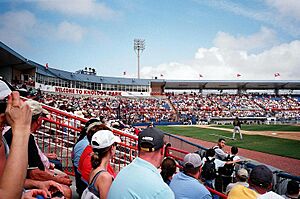
Dunedin has a Parks & Recreation Department. It offers many fun and affordable activities for residents. The city has four main recreation centers. Each one is designed for different age groups.
In 2007, Dunedin opened its newest and largest recreation center. This was the Dunedin Community Center. It cost over $10 million to build. The center has classrooms, dance and exercise rooms, a fitness center, and a gymnasium. It also has a kids' area, a game room, a library, and a playground.
The Dunedin Fine Art Center (DFAC) opened in 1975. It has become a well-known place for art classes and exhibits in the southeastern United States. DFAC is nearly 40,000 square feet (3,700 square meters). It has five art galleries, 15 art classrooms, a gift shop, a cafe, and a children's art museum. It offers great art experiences for people of all ages.
Since 1977, Dunedin has been the spring training home for the Toronto Blue Jays baseball team. It's also home to the Dunedin Blue Jays, a minor league team. In 2021, the Toronto Blue Jays even played some of their regular season games at TD Ballpark in Dunedin. This was due to travel rules during the COVID-19 pandemic. Dunedin is one of the smallest towns to host a Major League spring training team. TD Ballpark is located near the Dunedin Public Library. The library was founded in 1895 and is the oldest public library in Pinellas County.
Other fun recreation spots include:
- Martin Luther King Jr. Recreation Center – Has classrooms, a game room, a gym, outdoor basketball courts, and a skate park.
- Hale Seniors Activity Center – Offers rooms for events, classes, and meetings, plus an exercise room.
- Dunedin Nature Center – A great place to learn about local nature.
- Highlander Pool Complex/Kiwanis Spraygrounds – An outdoor pool open from April to September.
- Dunedin Country Club – A golf course open to the public. It was given to the city in 1930 for recreation.
Dunedin has many sports teams for the community. These include soccer, baseball, hockey, and softball. The city even had a shinty club, a Scottish sport, for a short time. In 2011, Dunedin made it legal to drive golf carts on about 60% of the city's streets.
City-owned parks include:
- Achieva Paw Park
- Amberlea Park and Playground
- Dunedin Recreation Center and Playground
- Eagle Scout Park
- Edgewater Park and Playground – A waterfront park with places for boats and kayaks.
- Elizabeth Skinner-Jackson Park and Playground – Features a basketball court.
- Hammock Park and Playground – Next to baseball fields used by Greater Dunedin Little League.
- Highlander Park
- Josiah Cephas Weaver Park and Playground
- Martin Luther King Jr. Recreation Center and Playground
- Scotsdale Park and Playground
- VFW Playground
Honeymoon Island State Park and Caladesi Island State Park are also in Dunedin. They are located on the west side, along St. Joseph Sound.
The city also owns the Dunedin Marina. It has 194 boat slips and is considered one of the best marinas on Florida's West Coast. The marina is on the Intracoastal Waterway. It is home to the Dunedin Boat Club, one of Florida's oldest sailing clubs.
Dunedin Public Library: A Place to Read and Learn
| Dunedin Public Library | |
|---|---|
| General information | |
| Location | Dunedin, Florida |
| Address | 223 Douglas Ave |
| Coordinates | 28°00′07″N 82°47′11″W / 28.0020°N 82.7865°W |
| Opened | 1996 |
The Dunedin Public Library has two locations. The Main Library is at 223 Douglas Ave. The Friends Branch Library opened in 2007 at 1920 Pinehurst Road. This library is the oldest public library in Pinellas County. In 1895, a resident named Christopher B. Bouton gave the city 200 books for public use. His brother owned the town's meeting hall. He gave it to the Dunedin Library Association to be a library and reading room. It became known as Library Hall.
By 1920, the library had grown to over 2,000 books. The Dunedin Woman's Club took over running it. Belle Culton Davies became Dunedin's first librarian that year. In 1935, the City of Dunedin took over the library when its collection reached 7,000 books. As more people used the library, it needed more space. New libraries were built in 1956 and 1964.
In the early 1990s, the library started using the internet and new technologies. They added public computers and made their services available online. In 1994, the city approved funding for a new, larger building. The old building was torn down, and a new one was built in the same spot. The new library opened on September 3, 1996.
The Dunedin Public Library offers many services. They deliver books to residents who can't leave their homes. They also have a seed library for gardening, a knitting group, and help with family history research. The library started a "Little Free Library" movement in Pinellas County. There are now thirteen Little Free Libraries in Dunedin. The Literacy Council of Upper Pinellas also helps adults learn to read at the library.
The Dunedin Public Library is part of the Pinellas Public Library Cooperative (PPLC). This is a group of all public libraries in Pinellas County, Florida.
Dunedin's Roads and Travel
Dunedin's main highway is US Route 19 Alternate. This road connects the city to other parts of Florida. Main Street and Pinellas County Road 1 help people get around locally.
The closest airport is St. Petersburg-Clearwater International Airport. It is located southeast of Dunedin.
Famous People from Dunedin
Many interesting people have connections to Dunedin. Here are a few:
- Clayton Andrews, a former baseball pitcher.
- Nadia Azzi, a talented classical pianist.
- Sean Burnett, a former baseball relief pitcher.
- Mike "Pinball" Clemons, a football player and coach. He was born and raised in Dunedin.
- Ron DeSantis, the current Governor of Florida.
- Sylvia Earle, a famous ocean explorer and marine biologist.
- George Lowe, a TV actor known for playing Space Ghost.
- Daniel Norris, a baseball pitcher.
- David Nutter, a TV director for shows like Game of Thrones. He graduated from Dunedin High School.
- Don Zimmer, a former baseball player, coach, and manager for many famous teams.
Images for kids
See also
 In Spanish: Dunedin (Florida) para niños
In Spanish: Dunedin (Florida) para niños


